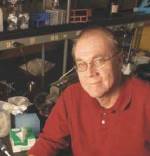 November 28: Chimps to humans by viral infection? Evidence that viruses played a big role in the evolutionary step from chimps to humans was announced in June. Since then the mechanism has gained wide notice. In November, Discover published a followup story, and the University of Georgia's The Red & Black published an interview with the principal researcher, John MacDonald. [Thanks Stan Franklin.]
November 28: Chimps to humans by viral infection? Evidence that viruses played a big role in the evolutionary step from chimps to humans was announced in June. Since then the mechanism has gained wide notice. In November, Discover published a followup story, and the University of Georgia's The Red & Black published an interview with the principal researcher, John MacDonald. [Thanks Stan Franklin.]
 Did Viruses Make Us Human?, by Kathy A. Svitil, Discover, Nov 2002.
Did Viruses Make Us Human?, by Kathy A. Svitil, Discover, Nov 2002.
 DNA reveals human-chimp split, by Blaine Ney, The Red & Black, 26 Nov 2002.
DNA reveals human-chimp split, by Blaine Ney, The Red & Black, 26 Nov 2002.
 2002, 1 August: "Evolutionary advance...," CA's first notice of the research.
2002, 1 August: "Evolutionary advance...," CA's first notice of the research.
 Viruses... is a related CA webpage. [Next-What'sNEW about HGT-Prev]
Viruses... is a related CA webpage. [Next-What'sNEW about HGT-Prev]
 2002, 27 August: "Red and Black article" — email from Klyce to MacDonald requesting clarification.
2002, 27 August: "Red and Black article" — email from Klyce to MacDonald requesting clarification.
November 25:
Bacteria could survive interplanetary travel, says Gerda Horneck, of DLR German Aerospace Center in Köln.
 Surviving the Final Frontier, by Stephen Hart, Astrobiology Magazine, 25 Nov 2002.
Surviving the Final Frontier, by Stephen Hart, Astrobiology Magazine, 25 Nov 2002.
 Bacteria... is a related CA webpage.
Bacteria... is a related CA webpage.
 November 24:
November 24:
Photosynthesis evolved by gene transfer. This is the essential conclusion of a recent whole-genome comparison that sought to ascertain how photosynthesis came into being. The thesis sentence of that study, published in Science, reads, "On the basis of genomic comparisons presented here, we propose that horizontal gene flow has played a major role in the evolution of bacterial phototrophs and that many of the essential components of photosynthesis have been among these horizontally transferred genes." ASU's press release says, "The analysis revealed clear evidence that photosynthesis did not evolve through a linear path of steady change and growing complexity but through a merging of evolutionary lines that brought together independently evolving chemical systems — the swapping of blocks of genetic material among bacterial species known as horizontal gene transfer."
This result further supports the evolutionary mechanism that we promote. For a discussion of the reasoning behind our claim, please see our newly added webpage, "Testing Darwinism versus Cosmic Ancestry," linked below.
 Jason Raymond et al., "Whole-Genome Analysis of Photosynthetic Prokaryotes" [abstract], p 1616-1620 v 298 Science, 22 Nov 2002.
Jason Raymond et al., "Whole-Genome Analysis of Photosynthetic Prokaryotes" [abstract], p 1616-1620 v 298 Science, 22 Nov 2002.
 Elizabeth Pennisi, "Bacteria Shared Photosynthesis Genes" [summary], p 1538-1539 v 298 Science, 22 Nov 2002.
Elizabeth Pennisi, "Bacteria Shared Photosynthesis Genes" [summary], p 1538-1539 v 298 Science, 22 Nov 2002.
 Photosynthesis Analysis Shows Work of Ancient Genetic Engineering, Arizona State University, 21 Nov 2002.
Photosynthesis Analysis Shows Work of Ancient Genetic Engineering, Arizona State University, 21 Nov 2002.
 Stitching Together Green Genes, Astrobiology Magazine online, 27 Nov 2002.
Stitching Together Green Genes, Astrobiology Magazine online, 27 Nov 2002.
 Two World-Altering Chemical Processes..., SpaceDaily, 17 Feb 2003 — "A critical part of the emerging evolutionary picture seems to be 'horizontal gene transfer' — genetic change that occurs by the exchange of genetic material between bacteria. This process allows for sudden evolutionary leaps that are perhaps not possible through gradual genetic change and natural selection."
Two World-Altering Chemical Processes..., SpaceDaily, 17 Feb 2003 — "A critical part of the emerging evolutionary picture seems to be 'horizontal gene transfer' — genetic change that occurs by the exchange of genetic material between bacteria. This process allows for sudden evolutionary leaps that are perhaps not possible through gradual genetic change and natural selection."
 Testing Darwinism versus Cosmic Ancestry is the new CA webpage that discusses these and other similar results.
Testing Darwinism versus Cosmic Ancestry is the new CA webpage that discusses these and other similar results.
 Viruses... is a related CA webpage. [Next-What'sNEW about HGT-Prev]
Viruses... is a related CA webpage. [Next-What'sNEW about HGT-Prev]
 New genetic programs... is a related CA webpage.
New genetic programs... is a related CA webpage.
November 7:
"The universe is full of microbes." This point is the only one on which Peter Ward and Charles Marshall agreed in their recent debate hosted by the Harvard-Smithsonian Center for Astrophysics. Ward, coauthor of Rare Earth, thinks intelligent life is quite rare in the universe, while Marshall, a Harvard paleontologist, says it's not rare. [Thanks, Larry Klaes.]
 Jascha Hoffman, "...Scientists debate the existence of intelligent life beyond Cambridge" [first paragraph], p D1, Boston Globe, 3 Nov 2002.
Jascha Hoffman, "...Scientists debate the existence of intelligent life beyond Cambridge" [first paragraph], p D1, Boston Globe, 3 Nov 2002.

 Bacteria... is a related CA webpage.
Bacteria... is a related CA webpage.
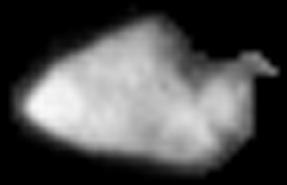 November 4:
November 4:
CIDA is not miscalibrated, according to Dr. Jochen Kissel of Max Planck Institute, Garching. In April, 2000, his team reported the detection of large organic molecules by the Cometary Impact Dust Analyzer aboard the Stardust mission. NASA subsequently expressed doubt about the result, saying the instrument might have given a false reading. We wondered if Stardust's recent flyby of asteroid Annefrank (pictured) had offered an opportunity to test CIDA's calibration, so we emailed Kissel and NASA to ask. No, CIDA collected no particles during the flyby of Annefrank. But Kissel defends the startling results of April, 2000, in his email, linked below.
 CIDA miscalibrated? — the email exchange with Kissel, 4 Nov 2002.
CIDA miscalibrated? — the email exchange with Kissel, 4 Nov 2002.
 The Physical and Chemical Properties of Interstellar Dust... — CA's webpage with Kissel's English translation of his team's German article announcing CIDA's detection of large organic molecules in interstellar particles, May 2000.
The Physical and Chemical Properties of Interstellar Dust... — CA's webpage with Kissel's English translation of his team's German article announcing CIDA's detection of large organic molecules in interstellar particles, May 2000.
 STARDUST Successfully Images Asteroid Annefrank During Dress Rehearsal, JPL, NASA, 4 Nov 2002.
STARDUST Successfully Images Asteroid Annefrank During Dress Rehearsal, JPL, NASA, 4 Nov 2002.
November 4:
Bacteria can survive high-speed impacts, according to Mark Burchell from the University of Kent at Canterbury, England. He is one of several researchers performing experiments that turn bacteria into microscopic crash test dummies. [Thanks, Michael Paine, Jim Galasyn and Larry Klaes.]
 Bacterial Blasting Across Space, by Morris Jones, SpaceDaily, 4 Nov 2002.
Bacterial Blasting Across Space, by Morris Jones, SpaceDaily, 4 Nov 2002.
 Scientists hurl rocks to study space bacteria, by Sue Vorenberg, The Daily Camera, 25 Nov 2002.
Scientists hurl rocks to study space bacteria, by Sue Vorenberg, The Daily Camera, 25 Nov 2002.
 Bacteria... is a related CA webpage.
Bacteria... is a related CA webpage.
 Comets... is a related CA webpage.
Comets... is a related CA webpage.
 November 2:
November 2:
Cyanobacteria may not be as old as we thought. A team led by Carrine Blank of Washington University has recently analyzed 38 genes from 53 species of extant bacteria, including cyanobacteria. "By mapping out the rates of change in the slowest-changing genes, Blank was able to generate a bacterial evolutionary history that shows cyanobacteria branching off last." Until now, we thought that cyanobacteria first appeared as early as 3.5 billion years ago, when they began to release free oxygen into the biosphere. According to the new analysis, cyanobacteria first appeared 2.3 billion years ago, in which case the source for the oxygen that produced the banded iron formations would have to be some other organism or process. The report was presented in Denver on 29 October, at the annual meeting of the Geological Society of America. [Thanks, Stan Franklin and SciQuest.]
All such reconstructions using comparative genomics depend on some uncertain assumptions: 1) molecular clocks are reliable, and 2) the ancient species was genetically similar to the modern species. Of course, bacterial phylogenies can be scrambled by horizontal transfer. The interesting question to us is, Where did the genetic programs for photosynthesis come from? Blank's analysis is not aimed at this question. We suspect the programs were installed by horizontal transfer in a genetically open system.
 Evolution Upset: Oxygen-Making Microbes Came Last, Not First, GSA Release 02-44, The Geological Society of America, 25 Oct 2002.
Evolution Upset: Oxygen-Making Microbes Came Last, Not First, GSA Release 02-44, The Geological Society of America, 25 Oct 2002.
 Gaia is a related CA webpage.
Gaia is a related CA webpage.
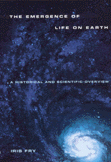 November 1:
November 1:
The Emergence of Life on Earth, by Iris Fry — If you are a non-scientists who wants an overview of origin-of-life research, this book is for you. Fry's reporting is thorough and wide-ranging, including, for example, Immanuel Kant's views on the subject. "The very possibility of the emergence of life from inorganic matter seemed absurd to Kant" (p 182).
Our main objection is that she is tightly bound by the gridlock of darwinism versus creationism throughout the book. For example, she writes, "The various hypotheses currently advanced by origin-of-life researchers... do not yet seem to suggest a convincing solution to the problem of the emergence of life. But no origin-of-life scientist considers that a reason to forsake the naturalistic worldview for the creation one " (p 8). Why is that the alternative? In conclusion she writes, "No single scenario has so far led to a reproduction in the laboratory of a possible synthesis of a living system. Researchers, however, do not regard this state of affairs as cause to abandon the scientific ship" (p 216). Nor as cause to re-examine any of their assumptions, apparently. She mentions Hoyle and Wickramasinghe, usually citing their most controversial passages. But panspermia, to her, is merely a variant of creationism.
Ranging into philosophy, she distinguishes methodological naturalism from ontological or metaphysical naturalism. But she never doubts the assumption — shared by darwinists and creationists — that life must have originated from nonliving matter in the finite past. She seems unaware that the assumption is, (as she disapprovingly quotes Bradley and Thaxton) "no more than 'a philosophical commitment quite apart from experience'" (p 204). [Thanks, Stan Franklin.]
 Iris Fry, The Emergence of Life on Earth: A Historical and Scientific Overview, ISBN 0-8135-2740-6, 256 pages, 8 b+w illus., $24.00, Rutgers University Press, 2000 [publisher's promo].
Iris Fry, The Emergence of Life on Earth: A Historical and Scientific Overview, ISBN 0-8135-2740-6, 256 pages, 8 b+w illus., $24.00, Rutgers University Press, 2000 [publisher's promo].
 Evolution vs Creationism is a related CA webpage.
Evolution vs Creationism is a related CA webpage.
 David Darling replies, 4 Nov 2002.
David Darling replies, 4 Nov 2002.
 October 31:
October 31:
Biastronomy 2002: Life Among the Stars, a symposium hosted by the Australian Centre for Astrobiology, was held 8-12 July, on Hamilton Island, adjacent to the Great Barrier Reef, Australia. Seventy speakers and over two hundred participants discussed "space chemistry, the formation of planets, planetary atmospheres and surfaces, the search for planets around other stars, origins of life on Earth, the search for primitive life elsewhere in the solar system, obstacles to the evolution of intelligent life; and the search for extraterrestrial intelligence (SETI)," reports Michael Paine in Sky and Space.
 Bioastronomy 2002: Life Among the Stars, conference homepage.
Bioastronomy 2002: Life Among the Stars, conference homepage.
 Life Among the Stars, by Michael Paine, Sky and Space, Oct/Nov 2002; hosted on the Internet by CC-Net. (Search the linked page for the string, "From Sky and Space".)
Life Among the Stars, by Michael Paine, Sky and Space, Oct/Nov 2002; hosted on the Internet by CC-Net. (Search the linked page for the string, "From Sky and Space".)
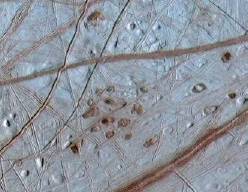 October 30:
October 30:
Europa acts like a planetary lava lamp, potentially transporting organisms up toward the surface, according to Dr. Robert Pappalardo, a planetary scientist at the University of Colorado, Boulder. The accompanying image, combined from two photos taken by the Galilleo mission, shows numerous hummocks and pits, each about 10 kilometers (6 miles) across. Episodic surges of warm water from deep under the ice produce these, says Pappalardo. To us the red pits look like erupted versions of the white hummocks. If so, the red pigmentation could be evidence of single-celled life similar to Chlamydomonas, transported to the surface or activated there by the erupting water. Pappalardo's report and other recent ones about Europa have been presented during the annual meeting of the Geological Society of America, 27-30 Oct, in Denver, CO. [Thanks, Ron Baalke.]
 Red Freckles on Europa Suggest 'Lava Lamp' Action, JPL, NASA, 30 Oct 2002.
Red Freckles on Europa Suggest 'Lava Lamp' Action, JPL, NASA, 30 Oct 2002.
 Europa's Freckles, Astronomy Picture of the Day, 1 Nov 2002.
Europa's Freckles, Astronomy Picture of the Day, 1 Nov 2002.
 ...Life on Europa or Other Moons?, a CA webpage, lists "What'sNEW" on this subject.
...Life on Europa or Other Moons?, a CA webpage, lists "What'sNEW" on this subject.
 October 30:
October 30:
Paul Davies thinks life came from Mars. [Thanks, Larry Klaes.]
 It's true, men really are from Mars, by Paul Davies, The Guardian, 29 Oct 2002.
It's true, men really are from Mars, by Paul Davies, The Guardian, 29 Oct 2002.
 ...Life on Mars! is the related CA webpage.
...Life on Mars! is the related CA webpage.
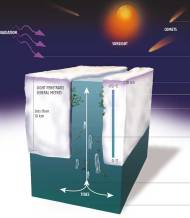 October 27:
October 27:
The ice on Europa may be 20 kilometers (13 miles) thick, according to a team led by Robert Pappalardo at the University of Colorado, Boulder. If so, "Motions of glacial ice may transport ocean material, and any life it might contain, to the surface." Knowing the thickness of the ice would help NASA design future missions to look for life there. [Thanks, Newshub and Larry Klaes.]
 Colorado U. space team studying ...potential life on ...Europa, EurekAlert! 25 Oct 2002. ("...13 miles....")
Colorado U. space team studying ...potential life on ...Europa, EurekAlert! 25 Oct 2002. ("...13 miles....")
 Life on Europa might be detectable, by Dan Whipple, UPI Science News, 30 Oct 2002. "Pappalardo said his model of Europa's geology suggests the ice covering is only about 2 kilometers (1.24 miles) thick." (We're confused.)
Life on Europa might be detectable, by Dan Whipple, UPI Science News, 30 Oct 2002. "Pappalardo said his model of Europa's geology suggests the ice covering is only about 2 kilometers (1.24 miles) thick." (We're confused.)
October 24:
Ice only 10 kilometers (6 miles) thick would favor life on Europa, according to Richard Greenberg and his team at the University of Arizona. They believe Europa's icy shell is this thin because some of the terrain seen by Galileo resembles ice blocks that once drifted in open water; and where ice plates have collided, the resulting tectonic uplift or horizontal compression seems weak, as if the ice were thin. The team believes that sunlight and flowing water might enable life such as seaweed and jellyfish to survive in cracks in the ice.
 Thin ice opens lead for life on Europa, by David L Chandler, New Scientist Online, 20 Oct 2002.
Thin ice opens lead for life on Europa, by David L Chandler, New Scientist Online, 20 Oct 2002.
 ...Life on Europa or Other Moons?, a CA webpage, lists "What'sNEW" on this subject.
...Life on Europa or Other Moons?, a CA webpage, lists "What'sNEW" on this subject.
 Max Wallis comments, long after, 27 Sep 2016.
Max Wallis comments, long after, 27 Sep 2016.
October 3:
The chance for life in ice-covered oceans on distant moons is reconsidered. New calculations by Christopher England of NASA JPL indicate that liquid water and an energy source, the essentials for life, may be available on more moons in the solar system than we thought previously. And earlier, geologist A. D. Fortes of University College London explores "the possibility that all of Titan's current atmospheric methane and free nitrogen is of biogenic origin." Wow. [Thanks, Jim McGee and Larry Klaes.]
 Life may swim within distant moons, by David Whitehouse, BBC News Online, 1 Oct 2002.
Life may swim within distant moons, by David Whitehouse, BBC News Online, 1 Oct 2002.
 Exobiological Implications of a Possible Ammonia-Water Ocean Inside Titan, by A. D. Fortes, University College London, 1999.
Exobiological Implications of a Possible Ammonia-Water Ocean Inside Titan, by A. D. Fortes, University College London, 1999.
 ...Life on Europa or Other Moons?, a CA webpage, lists "What'sNEW" on this subject.
...Life on Europa or Other Moons?, a CA webpage, lists "What'sNEW" on this subject.
